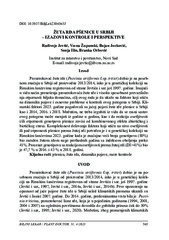Prikaz osnovnih podataka o dokumentu
Žuta rđa pšenice u Srbiji - izazovi kontrole i perspektive
Yellow rust of wheat in Serbia - control challenges and perspectives
| dc.creator | Jevtić, Radivoje | |
| dc.creator | Župunski, Vesna | |
| dc.creator | Jocković, Bojan | |
| dc.creator | Ilin, Sonja | |
| dc.creator | Orbović, Branka | |
| dc.date.accessioned | 2023-09-27T07:19:06Z | |
| dc.date.available | 2023-09-27T07:19:06Z | |
| dc.date.issued | 2023 | |
| dc.identifier.issn | 0354-6160 | |
| dc.identifier.uri | http://fiver.ifvcns.rs/handle/123456789/3748 | |
| dc.description.abstract | Prouzrokovač žute rđe (Puccinia striiformis f.sp. tritici) dobio je na posebnom značaju u Srbiji od proizvodne 2013/2014, iako je u genetičkoj kolekciji na Rimskim šančevima registrovan od strane Jevtića i sar. još 1997. godine. Imajući u vidu način prenošenja prouzrokovača žute rđe i visoku sposobnost prevazilaženja otpornosti biljaka domaćina, cilj ovog rada je da ukaže na faktore koji utiču na dinamiku pojave i osnovne probleme u kontroli ovog patogena u Srbiji. Klimatski faktori 2023. godine pogodovali su jačoj pojavi žute rđe pšenice u Srbiji kao i 2014, 2016. i 2018. Međutim, ne treba izgubiti iz vida da se rasni sastav ovog patogena može menjati iz godine u godinu, kao i da reakcija osetljivosti i/ili otpornosti genotpova pšenice zavisi od kombinovanog efekta abiotičkog i biotičkog stresa. Kompleksnost delovanja faktora koji utiču na nivo osetljivosti ili pad otpronosti pšenice prema žutoj rđi potvrđen je i u genetičkoj kolekciji na Rimskim šančevima 2023. godine kada je značajno veći broja genotipova (80%) bio zaražen žutom rđom nego prethodnih godina sa indeksom oboljenja preko 41%. Procenat genotipova sa reakcijom osetljivosti prema žutoj rđi (DI>41%) bio je 47,7 % u 2016. i 43 % u 2018. godini. | sr |
| dc.description.abstract | The causal agent of yellow rust (Puccinia striiformis f.sp. tritici) gained special attention in Serbia since the 2013/2014 production year, although its presence in the genetic collection at Rimski šančevi was noted by Jevtić et al. as early as 1997. Considering the mode of transmission of the yellow rust and its high ability to overcome host plant resistance, the aim of this study is to highlight the factors that influence the dynamics of its occurrence and the main challenges in controlling this pathogen in Serbia. The climatic factors in 2023 favored occurrence of wheat yellow rust in Serbia, similar to 2014, 2016, and 2018. However, it should be noted that the race composition of this pathogen can change from year to year, and the susceptibility and/or resistance of wheat genotypes to yellow rust depends on the combined effect of abiotic and biotic stressors. The complexity of factors influencing the level of susceptibility or resistance breakdown in wheat towards yellow rust has also been confirmed in the genetic collection at Rimski šančevi in 2023 when a significantly higher number of genotypes (80%) were infected with yellow rust compared to previous years, with a disease index exceeding 41%. The percentage of genotypes showing susceptibility reaction to yellow rust (DI>41%) was 47.7% in 2016 and 43% in 2018. | sr |
| dc.language.iso | sr | sr |
| dc.publisher | Novi Sad : University of Novi Sad, Faculty of Agriculture | sr |
| dc.relation | info:eu-repo/grantAgreement/MESTD/inst-2020/200032/RS// | sr |
| dc.rights | openAccess | sr |
| dc.rights.uri | https://creativecommons.org/licenses/by/4.0/ | |
| dc.source | Biljni lekar / Plant Doctor | sr |
| dc.subject | wheat | sr |
| dc.subject | yellow rust | sr |
| dc.subject | occurence dinamicity | sr |
| dc.subject | control measures | sr |
| dc.subject | pšenica | sr |
| dc.subject | žuta rđa | sr |
| dc.subject | dinamika pojave | sr |
| dc.subject | mere kontrole | sr |
| dc.title | Žuta rđa pšenice u Srbiji - izazovi kontrole i perspektive | sr |
| dc.title | Yellow rust of wheat in Serbia - control challenges and perspectives | sr |
| dc.type | article | sr |
| dc.rights.license | BY | sr |
| dc.citation.epage | 575 | |
| dc.citation.issue | 4 | |
| dc.citation.rank | M53~ | |
| dc.citation.spage | 565 | |
| dc.citation.volume | 51 | |
| dc.identifier.doi | 10.5937/BiljLek2304565J | |
| dc.identifier.fulltext | http://fiver.ifvcns.rs/bitstream/id/9599/bitstream_9599.pdf | |
| dc.type.version | publishedVersion | sr |


